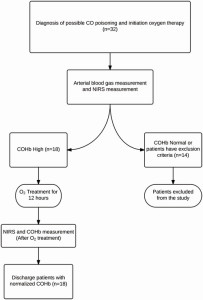<Title:> The Use of Cerebral Oximetry in Acute Carbon MonoxideIntoxication: A Preliminary Study
<Author(s):> Kalkan Asim, Bilir Ozlem, Ersunan Gokhan, Yazici Zihni, Ozel Deniz, Tas Mahmut, Yavasi Ozcan
<Corresponding author E-Mill:> asim.kalkan(at)erdogan.edu.tr
<Abstract:> The purpose of this study was to assess the clinical usefulness of near-infrared spectroscopy (cerebral oximetry) in patients presenting to the emergency department (ED) with carbon monoxide (CO) intoxication. Eighteen patients with a diagnosis of CO intoxication who presented to our ED during 2013 were included in this prospective study. All patients were treated and monitored according to the standard recommendations for CO intoxication. In addition, cerebral oxygen saturation (ScO2) was measured using near-infrared spectroscopy, also known as cerebral oximetry. Minimum and maximum ScO2 values from the right and left frontal region were recorded using cerebral oximetry from immediately after presentation to the ED until discharge. Patient blood carboxyhemoglobin (COHb) levels before and after oxygen treatment were compared with the cerebral oximetry measurements. At the time of admission, mean blood (COHb) values were 29.3% ± 6.7%, and ScO2 values were 59.0 ± 4.0 in the right frontal region and 60.9 ± 5.1 in the left. When blood COHb levels had returned to normal following oxygen therapy, ScO2 values were 75.9 ± 6.1 (65.5 90.5) in the right frontal region and 74.9 ± 7.8 (62.0 90.0) in the left. The differences in ScO2 values before and after oxygen therapy were statistically significant (P 0.005). Assessment of patients exposed to CO gas using cerebral oximetry can provide information about cerebral oxygen saturation. Blood COHb level measurement is still the best method for diagnosing CO intoxication; however, cerebral oximetry, a non-invasive technique, may be an effective method for assessing cerebral oxygen saturation.
<Keywords:> carbon monoxide, intoxication, cerebral oximetry, cerebral oxygenation
<URL:> https://www.jstage.jst.go.jp/article/kjm/64/4/64_2014-0010-OA/_article


![Regulatory T Cells: Pathophysiological Roles and Clinical Applications [Published online in advanced , by J-STAGE]](http://kjm.pupu.jp/blog/wp-content/uploads/2019/07/2019-0003-OA-100x100.jpg)
![A Case of Pancreatic Side Effects Resulting from Sorafenib and Axitinib Treatment of Stage IV Renal Cell Carcinoma [Published online Keio J Med, 64, 62-64, by J-STAGE]](http://kjm.pupu.jp/blog/wp-content/uploads/2015/12/2015-0001-CR-100x100.jpg)
![Warfarin-associated Intraspinal Hematoma [Published online in advanced , by J-STAGE]](http://kjm.pupu.jp/blog/wp-content/uploads/2016/05/2015-0012-CR-100x100.jpg)
![Organoids: Avatars for Personalized Medicine [Published online Keio J Med, 68, 95-95, by J-STAGE]](http://kjm.pupu.jp/blog/wp-content/uploads/2019/12/68-006-ABST-100x100.jpg)
![Clinical Significance of Right Ventricular Function in Pulmonary Hypertension [Published online in advanced , by J-STAGE]](http://kjm.pupu.jp/blog/wp-content/uploads/2021/01/2020-0015-IR-100x100.jpg)
![Pachyonychia Congenita: Clinical Features and Future Treatments [Published online in advanced , by J-STAGE]](http://kjm.pupu.jp/blog/wp-content/uploads/2023/09/2023-0012-IR-100x100.jpg)
![The Role of the Adipocyte Hormone Leptin in Alzheimer’s Disease [Published online Keio J Med, 65, 21-21, by J-STAGE]](http://kjm.pupu.jp/blog/wp-content/uploads/2016/03/65-002-ABST-100x100.jpg)
![Clinical Serum Therapy: Benefits, Cautions, and Potential Applications [Published online in advanced , by J-STAGE]](http://kjm.pupu.jp/blog/wp-content/uploads/2017/04/2016-0017-IR-100x100.jpg)
![Metabolism in Human Pluripotent Stem Cells and Cardiomyocytes for Regenerative Therapy [Published online Keio J Med, 71, 55-61, by J-STAGE]](http://kjm.pupu.jp/blog/wp-content/uploads/2022/09/2021-0015-IR-100x100.jpg)
![Outbreak of Health Care-associated Novel Coronavirus (SARS-coV-2) COVID-19 infections in the Spring of 2020 [Published online Keio J Med, 70, 1-6, by J-STAGE]](http://kjm.pupu.jp/blog/wp-content/uploads/2021/03/kjm-covid19-01-100x100.jpg)